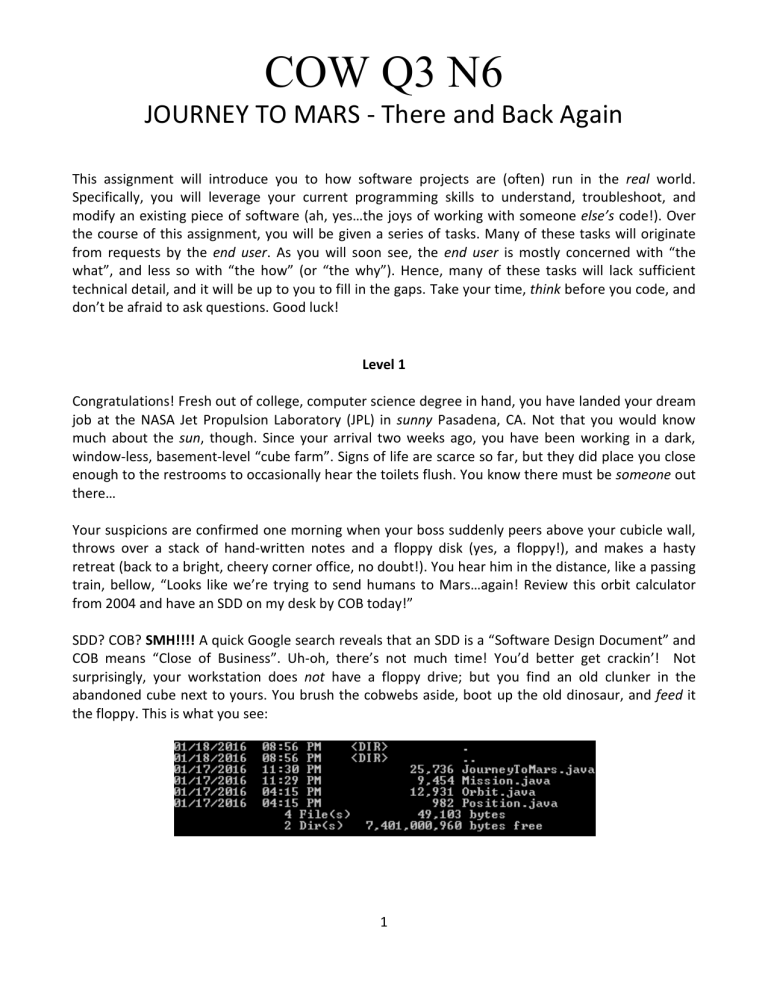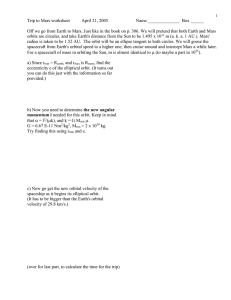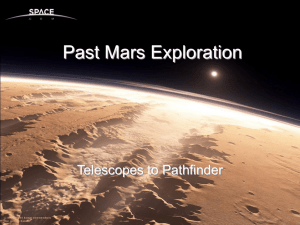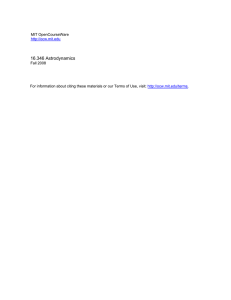COW Q3 N6

COW Q3 N6
JOURNEY TO MARS - There and Back Again
This assignment will introduce you to how software projects are (often) run in the real world.
Specifically, you will leverage your current programming skills to understand, troubleshoot, and modify an existing piece of software (ah, yes…the joys of working with someone else’s code!). Over the course of this assignment, you will be given a series of tasks. Many of these tasks will originate from requests by the end user. As you will soon see, the end user is mostly concerned with “the what”, and less so with “the how” (or “the why”). Hence, many of these tasks will lack sufficient technical detail, and it will be up to you to fill in the gaps. Take your time, think before you code, and don’t be afraid to ask questions. Good luck!
Level 1
Congratulations! Fresh out of college, computer science degree in hand, you have landed your dream job at the NASA Jet Propulsion Laboratory (JPL) in sunny Pasadena, CA. Not that you would know much about the sun, though. Since your arrival two weeks ago, you have been working in a dark, window-less, basement-level “cube farm”. Signs of life are scarce so far, but they did place you close enough to the restrooms to occasionally hear the toilets flush. You know there must be someone out there…
Your suspicions are confirmed one morning when your boss suddenly peers above your cubicle wall, throws over a stack of hand-written notes and a floppy disk (yes, a floppy!), and makes a hasty retreat (back to a bright, cheery corner office, no doubt!). You hear him in the distance, like a passing train, bellow, “Looks like we’re trying to send humans to Mars…again! Review this orbit calculator from 2004 and have an SDD on my desk by COB today!”
SDD? COB? SMH!!!! A quick Google search reveals that an SDD is a “Software Design Document” and
COB means “Close of Business”. Uh-oh, there’s not much time! You’d better get crackin’! Not surprisingly, your workstation does not have a floppy drive; but you find an old clunker in the abandoned cube next to yours. You brush the cobwebs aside, boot up the old dinosaur, and feed it the floppy. This is what you see:
1
Exercise 1A: Review the four Java files shown in the previous figure. In the space below, list each associated class (e.g. JourneyToMars, Mission, etc.) and include one sentence that describes what function that class performs. HINT: Don’t waste too much time trying to understand everything about a given class. Look at the comments included in each Java file to get a general idea of what the class does.
Exercise 1B: Draw a simple diagram that illustrates how the four classes are related. For instance if
Class A creates an instance of Class B (e.g., ClassB classb = new ClassB()), draw blocks that represent the instances of Class A and Class B. Label each block with the name of the given instance (e.g.,
classb) and draw a line between them. The resulting class diagram will resemble a family tree. HINT:
Use the occurrences of the “new” command in the four Java files to find connections between the four classes. Alternatively, open the project in Bluej (or similar IDE) and use their graphical “relation”
capability.
Exercise 1C: Compile and run the Journey To Mars program. Give the program a whirl to get a feel for what it does. While much of it might look like Greek to you now, try to relate some of the program’s functions to your analysis in the previous two exercises. HINT: The right and left arrow keys make the worlds go ‘round.
2
Level 2
Just as the clock strikes quittin’ time, you place the SDD on your boss’s desk and breathe a sigh of relief. With a quick glance, he reviews your work, and then looks up with a smile. “Nice job!” he says.
“You seem to have a good understanding of how this program works.” He points to a stack of papers on his desk and adds, “As you can see, I’ve got a bunch of whiney engineers on the third floor who won’t stop bugging me with change requests. To tell you the truth, I don’t have time for this. In fact, I could give a rat’s aaa…” His words trail off as he looks at the pile of papers, then turns back to you with a grin, “…ssso, I am appointing you team lead on this project! I need the final version of the software delivered to the third floor engineering department no later than one week from today.”
You stand dumbfounded in his office, and by the time you recover your senses enough to speak, your boss has left for the evening.
Over the next few days, you wait patiently in your cube for your team to arrive, but hear only the sounds of the ghostly toilets flushing. It’s quickly becoming clear that your “team” is a team of one. If this project is going to get done, it’s going to be all up to you! You glance at the pile of software change requests (often called “CR’s”) now on your desk and grab the one on the top…
12 x3941 dunkinjoe@jpl.nasa.gov
Joe Bagofdonuts
1-27 x x
Add the Sun!
Where is the sun? Without the Sun, what is making the planets go ‘round?
Dark matter? A black hole? Geez, even a computer programmer should understand the basic laws of physics!
Exercise 2A: Read this CR carefully (try your best to ignore the smart-aleck comments of the engineer who submitted it). Compile and run the Journey To Mars program and see if you can form a preliminary understanding of how this request applies. Proceed to Exercise 2B.
Exercise 2B: Add “the Sun” to the center of the orbit animation window (top right) by updating the
drawSun function of the Mission class. Use the fillOval (java.awt.Graphics) function. Be creative, but choose a color scheme and an overall size that is appropriate (you want to ensure that the end user
actually recognizes it as “the Sun”). HINT: The overall pixel dimensions of the orbit animation window are given by the Mission class variables: “width” and “height”.
3
Level 3
Encouraged by your early success (that’s a great-looking Sun you added, by the way!), you eagerly address the other CR’s on the stack, one-by-one. Your boss is going to be so proud of your work…
25
Vinny Velveeta
1-15 x cutthecheese@jpl.nasa.gov
x3837 x
Fix the day function buttons: (1) Add Day, (2) Minus Day, and (3) Reset
Day.
Waddya think we are? Mindreaders? The only way to change the mission day is using the (apparently secret) keyboard controls. How about bringing this code into the new century and giving us some working GUI controls!
Geeezzz! One thing is becoming apparent…the engineers on the third floor really think a lot of themselves. They clearly have no respect for computer programmers either. Not to mention, every engineer ranks his/her request as high priority. You’ll have the last laugh, though. From now on, any request with attitude (like this one) goes right to the bottom of the pile! Ha! Put that in your pocket protector, Mr. Engineer!
Exercise 3A: The day variable is a member of the Mission class. This variable determines the current positions of all orbiting objects (Earth, Mars, and spaceship).
When the user clicks the “Reset Day” button, the current day should be set to 0. Update the resetDay function of the JourneyToMars class to enable this functionality. HINT: Use the setDay function of the
Mission class to set the value of day.
Exercise 3B: Update the incrementDay function of the Mission class to increment the day variable by the number of days specified by the dDay parameter. Ensure that day can never be less than zero.
HINT: Use the setDay function of the Mission class to set the value of day.
Exercise 3C: When the user clicks the “+” button, the current day should increase by 1. Update the
addDay function of the JourneyToMars class to enable this functionality. HINT: Use the incrementDay function you created in 3B.
Exercise 3D: When the user clicks the “-” button, the current day should decrease by 1. Update the
minusDay function of the JourneyToMars class to enable this functionality. HINT: Use the incrementDay function you created 3B.
4
Level 4
Working feverishly in your cubicle, you suddenly have the feeling that you are being watched. Peering up towards the cubicle entryway, you half expect to see a ghost. After all, it has been days since you saw another human being in your subterranean workspace. Instead, you are greeted by a rotund, bespectacled, middle-age man – truly a Dilbert comic strip character incarnate. “Are you the new kid who is working the orbit simulator?” he asks. “I have a new CR.” He hands you a piece of paper and makes a quick retreat, adding, “It’s high priority!” You let out a quiet groan, thinking, “Of course it’s high priority. They are all high priority!” Yet, somehow, this one is different. Perhaps it’s because you are so starved for human contact? Or maybe he reminds you of your Uncle Ted? Or it could just be like your grandmother always says, “The squeaky wheel gets the grease.” Whatever the reason, you decide to move it to the top of the heap…
108 glassceiling@jpl.nasa.gov
x3997 Wally Wonka
1-28 x x
Draw orbits of Earth and Mars
In his theory of general relativity, Einstein states that objects (e.g., the Sun) warp space-time. Furthermore, space-time governs the motion of objects (e.g., the Earth). The orbit outlines requested above are the embodiment of these tenets. Therefore, this request can be considered as coming from Einstein himself.
After reviewing the CR, four words come to mind, “GIVE” “ME” “A” “BREAK”! The nerve of some people! You briefly consider calling “Dr. Einstein” at extension 3997, but figure he is probably working hard on a “Theory of Everything” (good luck with that, Albert!). Instead, you swallow your pride, and get to work.
Exercise 4A: Draw the orbits of Earth and Mars by updating the drawOrbit function of the Orbit class.
In the Orbit class, the xy-coordinates of the given orbit are contained in the class variable positions.
This variable is an array of type Position. The x and y coordinates of a given Position can be accessed using the getX and getY functions, respectively.
In this exercise, use the drawPolyline (java.awt.Graphics) function to draw the orbit. To use this function, you will need to build two integer arrays, x and y, using the xy-coordinates contained in the
positions array. In addition, the xy-coordinates in positions will need to be converted to pixel values and centered in the animation window. This conversion is shown below: x = x positions
* scale + xOffset y = y positions
* scale + yOffset where scale, xOffset, and yOffset are parameters passed to the drawOrbit function.
5
Level 5
Exhausted, you reach for the last CR on your desk and give it a look. Your hopes for an “easy one” are soon dashed. “This is not going to be fun,” you mutter to yourself as you crack open your last can of
Red Bull…
107
Johnny Rocket
1-25 dofriesgowiththatshake@jpl.nasa.gov
x3835 x x
Calculate and display the current linear (dD) and angular (dAng) separations between Earth and Mars.
Predict the “Age of Aquarius”. To quote those seers of the cosmos, The 5 th
Dimension, “When the moon is in the Seventh House. And Jupiter aligns with Mars. Then peace will guide the planets. And love will steer the stars. This is the dawning of the Age of Aquarius”
Exercise 5A: The leftmost window in the Journey To Mars orbit calculator provides useful information to the mission engineer, including orbital parameters (semi-major axis, eccentricity, period, etc.), velocities, energy requirements (called delta V), and trajectory times. Two values of particular interest when calculating an orbit connecting two solar system bodies (e.g. Earth and Mars) are their angular (dAng) and linear (dD) separations. These parameters are illustrated below:
Mars dD dAng
Sun
Earth
Update the getEarthMarsDistance function of the Mission class to calculate and return the current distance between the two planets.
HINT: The current day of the mission can be obtained from the getDay function of the Mission class. The current position of a given planet can be obtained using the getPositionAt function of the Orbit class. The distance between two Positions can be calculated by the
getDistanceTo function of the Position class.
Exercise 5B: Update the getEarthMarsAngle function of the Mission class to calculate and return the angular distance (in degrees) between the two planets. This function should return the absolute
value of the angular distance in the range from 0 to 180 degrees. HINT: The current day of the mission can be obtained from the getDay function of the Mission class. The current position of a given
planet can be obtained using the getPositionAt function of the Orbit class.
6
The Rest Of The Story
After a straight week of non-stop coding, you successfully addressed all (108!) CR’s and delivered the updated Journey to Mars orbit simulator to the 3 rd floor engineering department. Nice job! Your boss was so impressed with your work that he moved you from your underground cubby to a bright, cheery office right next to his. This seemed like a fantastic upgrade until you realize…your office is
right next to his! (No more extended lunch breaks or catnaps for you!)
Looking back on it, this whole experience has taught you many valuable lessons:
1.
Programming involves more than coding. It also requires communication, patience, and persistence.
2.
Engineers can be self-absorbed and condescending; and many have funny names.
3.
Requests from software users can be vague, demanding, and even sometimes misinformed. It is often up to the programmer to make sense of these requests, reduce their scope as needed, and even correct them. This process requires the skills cited in #1.
4.
Space is cool.
5.
In life and in your career, it’s important to know how (and when) to keep your head low
(you’re really pining for that quiet, basement cubicle right about now, aren’t you?)
In addition to many important life lessons, this effort has left you with a deep sense of pride. After all, your hard work has helped launch the manned exploration of our solar system. One day, you will be able to tell your grandchildren that you helped put people on Mars!
Unfortunately, there is still one more lesson left to learn from this exercise…politicians run the world.
Sadly, your work at JPL began during an election year. Less than five months later, Obama was out and Trump was in. At his first State Of The Union address, President Trump stated, “My administration will halt all efforts to launch a manned-mission to Mars. Instead, we will focus our attention on building a “space wall” to keep aliens, like the Martians, from landing on the Earth illegally. Even better, we will make the Martians pay for this wall!”
So much for our Journey to Mars…
7



